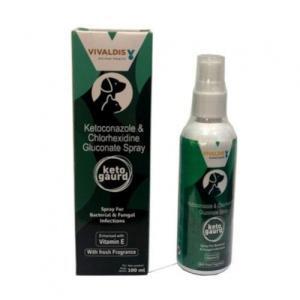Table of Contents
Taking care of a pet’s skin is crucial for several reasons. A healthy skin barrier is the first line of defense against infections, allergens, and environmental pollutants, contributing to their overall well-being. Proper skin care prevents discomfort and irritation, helping pets lead a more comfortable and happy life. Regular skin maintenance can aid in the early detection of potential health issues, allowing for prompt medical intervention. Maintaining healthy skin reduces the risk of excessive scratching or licking, which can lead to secondary infections and injuries. Lastly, a well-cared-for coat and skin contribute to a pet’s appearance, enhancing their physical and emotional bond with their owner.

What Is Keto Guard Spray?
Vivaldis’ Keto Guard boasts ketoconazole and chlorhexidine gluconate as its key components. This formulation is a potent remedy against an extensive array of bacterial, fungal, and yeast infections, as well as diverse skin afflictions in dogs and cats. It is especially effective for addressing hotspots, dermatitis, and ringworm infections. Enriched with the goodness of Vitamin E, it emanates a delightful fragrance. This product demonstrates its prowess in combatting diverse strains of fungi and bacteria, contributing to the health and well-being of your beloved pets.
Ingredients
Ketoconazole and Chlorhexidine Gluconate are the dynamic active ingredients within the Keto Guard Spray. Ketoconazole, an antifungal agent, is pivotal in combatting fungal infections afflicting a pet’s skin and coat. It inhibits the growth and reproduction of various fungi, including yeast, helping to alleviate discomfort and restore skin health.
Chlorhexidine Gluconate, on the other hand, acts as a powerful antimicrobial agent. It targets a broad spectrum of bacteria and helps prevent and control bacterial infections. Its antiseptic properties make it highly effective in maintaining skin hygiene, particularly in irritations, wounds, and infections.
Together, these two active ingredients create a synergistic effect that addresses a broad range of pet skin-related issues. From fungal infections to bacterial problems, Keto Guard Spray harnesses the potency of Ketoconazole and Chlorhexidine Gluconate to provide comprehensive care, promoting healthier skin and enhancing the well-being of furry companions.
How to Use
For optimal results, adhere to the recommended dosage. Gently spray Keto Guard directly onto the affected areas 2-3 times a day, following the prescribed guidance of your veterinarian. This regimen ensures the effective application of the product, supporting the healing process and your pet’s well-being.
Important Safety Information
Consult your veterinarian before spraying, especially if your pet has pre-existing medical conditions or is on other medications.
When spraying, prevent contact with your pet’s eyes and ears. If accidental contact occurs, rinse thoroughly with water.
Keto Guard Spray is intended for external use on the skin only. Do not administer orally or allow ingestion.
Monitor your pet for any signs of allergic reactions or sensitivities. Discontinue use if redness, irritation, or other adverse reactions develop.
Adhere strictly to the recommended dosage instructions. Overuse may lead to unintended side effects. Dispose of the container responsibly and in accordance with local regulations.
Be cautious when spraying to sensitive areas or open wounds, as it might cause discomfort.
Consult your veterinarian before using the spray on pregnant or nursing pets.
Veterinary Prescription
The requirement for a veterinary prescription to purchase Keto Guard Spray may vary depending on the country, local regulations, and the product’s specific formulation. Some over-the-counter (OTC) pet care products can be purchased without a prescription, while others may require one.
We recommend checking with your local veterinary clinic, pet supply stores, or the manufacturer’s official website to determine whether you need a veterinary prescription to buy Keto Guard Spray. Additionally, if you’re uncertain, it’s always a good idea to consult your veterinarian.
Interactions
Keto Guard Spray, containing active ingredients like ketoconazole and chlorhexidine gluconate, may interact with certain substances or conditions. Here is some general information:
- Other Medications: If your pet is already taking other medications, especially those that affect the liver or have potential interactions with antifungal or antimicrobial agents, consult your veterinarian before using Keto Guard Spray.
- Underlying Health Conditions: Pets with certain medical conditions, such as liver or kidney problems, may have a higher risk of adverse effects when using ketoconazole products. Discuss your pet’s health history with your veterinarian to ensure safe usage.
- Allergies: If your pet has a known sensitivity or allergy to ketoconazole, chlorhexidine, or any other ingredients in the spray, it’s important to avoid using the product.
- Pregnancy and Nursing: If your pet is pregnant or nursing, consult your veterinarian before using Keto Guard Spray, as certain medications may have varying effects on developing fetuses or nursing offspring.
- Open Wounds or Sensitive Areas: Exercise caution when spraying on open wounds, broken skin, or sensitive areas, as it may cause discomfort or irritation.
- Environmental Exposure: While Keto Guard Spray is intended for external use, avoid allowing your pet to ingest the product. Additionally, be mindful of potential environmental exposure, especially if other animals or small children are present.
- Long-Term Use: Prolonged use of antifungal or antimicrobial agents could lead to the development of resistant organisms. Consult your veterinarian about the appropriate duration of use for your pet’s condition.
- Monitoring: Keep a watchful eye on your pet for any signs of adverse reactions, including redness, swelling, itching, or other unusual behavior, and consult your veterinarian if such reactions occur.
If your pet takes other medications or has underlying health conditions, consult a professional to ensure that using Keto Guard Spray is safe and appropriate for your pet’s specific situation.

Side Effects
Keto Guard Spray, containing ketoconazole and chlorhexidine gluconate, may have potential side effects. Remember that individual pets can react differently, and not all pets will experience side effects. Here are some potential side effects to be aware of:
- Skin Irritation: Some pets may experience skin irritation, redness, itching, or a rash at the application site. This can indicate an allergic reaction or sensitivity to the product.
- Dry or Flaky Skin: The antifungal properties of ketoconazole could lead to dryness or flakiness of the skin.
- Hair Loss: In rare cases, localized hair loss could occur at the application site. This is usually temporary and resolves after discontinuing the product.
- Gastrointestinal Upset: If a pet licks the sprayed area, there’s a possibility of gastrointestinal upset, including nausea, vomiting, or diarrhea.
- Systemic Effects: Although topical products are generally less likely to cause systemic effects, some absorption can occur. In rare cases, systemic side effects like changes in liver enzymes might occur, especially with prolonged use.
- Allergic Reactions: Pets with allergies or sensitivities may experience more pronounced reactions, such as swelling, hives, or difficulty breathing.
- Behavioral Changes: In some cases, pets might exhibit behavioral changes such as increased agitation or restlessness after application.
- Discoloration of Fur: Chlorhexidine may cause temporary fur discoloration in light-colored pets. This is generally reversible and fades over time.
- Changes in Odor or Taste: Some pets might exhibit changes in odor or taste perception due to the ingredients in the spray.
- Rare Severe Reactions: While infrequent, severe reactions like anaphylaxis can occur. If you notice extreme distress or difficulty breathing, seek emergency veterinary care immediately.
If you notice any concerning symptoms, discontinue use and consult your veterinarian promptly.
It’s essential to perform a patch test before applying the product to a larger area. Apply a small amount of the spray on a small skin patch and monitor for any adverse reactions over a few hours. If there’s no reaction, you can use the product as directed.
Overdose
Using excessive Keto Guard Spray or applying it more frequently than recommended can lead to an overdose situation for your pet. Overdosing on any medication or topical product can have adverse effects and should be avoided. If you suspect that your pet has been exposed to an overdose of Keto Guard Spray, take the following steps:
- Immediately stop using the spray on your pet.
- Contact your veterinarian as soon as possible to inform them about the situation. They can guide how to proceed based on the specific circumstances.
- Keep a close eye on your pet for any signs of adverse reactions or symptoms of overdose, such as excessive itching, redness, swelling, vomiting, diarrhea, lethargy, or any unusual behavior.
- Your veterinarian will advise you on the appropriate course of action. They recommend monitoring your pet’s condition at home or bringing them in for an examination.
- Ensure that your pet cannot access the spray bottle or any treated areas until you receive guidance from your veterinarian.
To prevent overdosing in the future, always follow the recommended dosage and usage instructions provided by your veterinarian or on the product label.
Storage
Store the spray in a cool, dry place, away from direct sunlight and heat sources. Avoid storing it in areas with high humidity, as moisture can affect the product’s stability.
Store the spray in a location that is out of reach of children and pets. This prevents accidental ingestion or exposure.
Store the spray in its original packaging or container. The packaging is designed to protect the product from external elements and maintain its integrity.
Check the expiration date on the product label. Please do not use the spray beyond its expiration date, as the effectiveness and safety of the ingredients might be compromised.
Avoid storing the spray in places where temperatures fluctuate considerably or where it might be exposed to extreme cold or heat. Extreme temperatures can impact the product’s stability.
Store the spray away from food items and pet supplies to prevent accidental contamination.
FAQ
What is Keto Guard Spray used for?
Keto Guard Spray is used to treat various bacterial, fungal, and yeast infections and skin conditions like hotspots, dermatitis, and ringworm infections in dogs and cats.
Can I use Keto Guard Spray on open wounds?
It’s advisable to exercise caution when using the spray on open wounds or broken skin. Consult your veterinarian for appropriate guidance.
Can I use Keto Guard Spray on pregnant or nursing pets?
Please consult your veterinarian before spraying pregnant or nursing pets to ensure its safety.
Can I use Keto Guard Spray on both dogs and cats?
Yes, Keto Guard Spray is designed for dogs and cats. However, follow the dosage and usage instructions specific to each species.

































